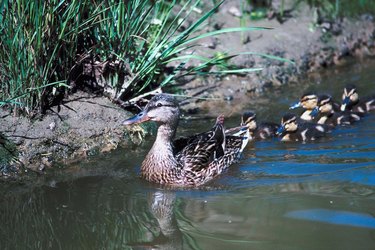Ducks follow a yearly life cycle of ducks that includes growth, migration and parenting. Independent of motherly supervision by a few months of age, young ducklings must fly south for the winter at four or five months of age. After spending a winter season in the warm climates, these same ducks, not quite a year old, must return to the grounds where they were hatched and begin the life cycle anew, raising their own brood of baby ducklings.

Video of the Day
Life cycle of ducks: eggs
The mother of a duckling is a devoted parent. Once they have found the perfect spot for their nest, they settle for an extended period of nest-sitting, serving as the incubator for the baby ducklings growing inside the eggs. A mother duck will stay on the nest almost exclusively, only leaving for the briefest spells to eat.
Video of the Day
After almost a month, the eggs will begin to hatch. The length of this process will depend upon the number of eggs, but usually lasts a full day. The ducklings are the most vulnerable to predators during their first two weeks of life, so mother ducks keep a close eye on the brood during this time.
Life cycle of ducks: ducklings
Ducklings continue to stay within the protective shelter of their mother's supervision until they are 1 1/2 to 2 months old. During this time, they are able to swim and catch their own food, but it may take a few tries for them to learn what is edible and what isn't. Baby ducklings still need the warmth of their mother's down feathers, so she snuggles them each night to keep them warm.
Some duckling types, such as Mallard ducklings, must also be protected by their mother from other full-grown ducks, as they have a tendency to kill unfamiliar ducklings that wander into their family grouping. At 2 months ducklings can fly and are able to leave the protection of their mother's watchful eye.
Life cycle of ducks: Teenagers
By the autumn, ducklings are basically on their own and ready for two important events — molting and migration. Replacing old feathers with new is a seasonal part of the duck's life cycle, yet it leaves them vulnerable to predators, since the process renders them incapable of flying. Molting lasts from two to three weeks.
Once molting is complete, the ducks migrate to warmer climates for the winter. Since the newly grown ducklings have only known the duck's breeding environment, the travel to the wintering habitat is a completely new experience for these youngest ducks. The mother duckling often assist these new migrants in finding and settling into the wintering habitat.
Life cycle of ducks: adults
While ducks are wintering in southerly climates, they do a great deal of eating, storing reserves for the time of migration and breeding that awaits them in the spring. The ducks return to the location where they were born not a full year previous and mate, locate a perfect nesting spot and, if the duck is female, lay eggs and sit on the nest to await the birth of the newest batch of ducklings.
Once the nesting site is located, male ducks do not play any role in this nest-sitting or duckling-rearing. Instead, they often leave the nest area and travel to another location, going through a spring molting process.